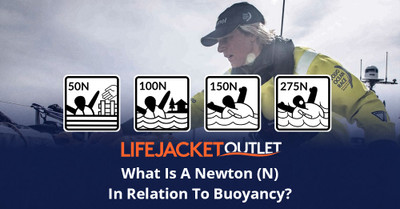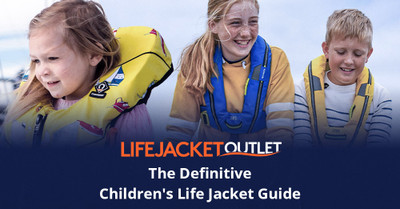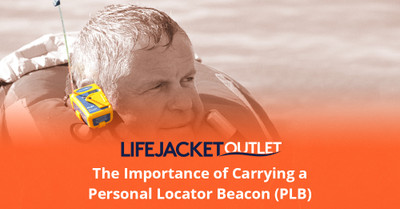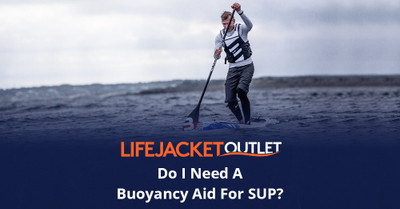3rd Jul 2025
When shopping for a lifejacket or buoyancy aid, you'll come across numbers like 50N, 100 N, 150N, or even 275N. But what exactly do these numbers mean? What is a Newton (N) in this context, and how does it relate to your safety in the water?
Let’s break it down in simple terms, while still giving you the full picture.
What Is a Newton (N)?
A Newton (N) is a unit of force, named after Sir Isaac Newton. It’s used in the metric system to measure things like weight, pressure, and - in our case - buoyancy.
1 Newton = the force required to accelerate 1 kg of mass at 1 metre per second squared.
In practical terms, 1 Newton = about 0.10197 kg of force, or roughly 0.225 pounds.
So when a buoyancy aid says "50 N buoyancy", that means it can provide an upward force of 50 Newtons - enough to support roughly 5 kg (11 lbs) of weight in water.
How Buoyancy Works with the Human Body
Your body already has some natural buoyancy. This is because your body is mostly water, and water supports water - so you’re already fairly "neutrally buoyant" even without a lifejacket. Fat and air in your lungs also add to your buoyancy.
However, clothes, boots, and gear can weigh you down, and in cold water, your body’s ability to stay afloat drops significantly.
That’s where Newton-rated buoyancy aids and lifejackets come in - to add enough upward force to keep you afloat, safe, and breathing, even in challenging conditions.
Newtons to Kilograms: A Simple Comparison:
| Buoyancy Rating | Newtons (N) | Approximate Lift | Suitable For |
| 50N | 50 Newtons | ~ 5kg | Buoyancy aids for swimmers/sports like kayaking. |
| 100N | 100 Newtons | ~ 10kg | Basic life jackets, suitable for calm waters. |
| 150N | 150 Newtons | ~ 15kg | Standard coastal and inshore life jackets - self righting. |
| 275N | 275 Newtons | ~ 28kg | Extreme conditions, heavy clothing and offshore use. |
So if you're wearing wet-weather gear, boots, or carrying equipment, you’ll need a lifejacket with higher Newtons to overcome the extra weight and keep you floating upright.
What Newtons Don't Tell You:
It’s important to understand that more Newtons doesn’t always mean better: it's about the right level of buoyancy for your situation.
Here’s what Newton ratings don’t tell you:
- Fit - Even the best lifejacket won’t work properly if it doesn’t fit snugly.
- Features - Spray hoods, crotch straps, lights, whistles, and harnesses matter too.
- Inflation Type - Manual or automatic activation can affect how quickly it works.
- Self-righting - Only some life jackets (usually 150N or higher) are designed to turn you face-up if unconscious.
Newton Ratings and ISO Standards:
In the UK and EU, lifejackets and buoyancy aids are certified according to ISO 12402 standards, which define the Newton ratings:
| ISO Rating | Buoyancy | Notes |
| ISO 12402-5 | 50N | Buoyancy aid - for competent swimmers in sheltered waters. |
| ISO 12402-4 | 100N | Life jacket - minimum for non-swimmers in calm waters. |
| ISO 12402-3 | 150N | Life jacket - for general offshore or rough conditions. |
| ISO 12402-2 | 275N | Life jacket - for extreme use, heavy clothing, long offshore trips. |
Always look for CE marking or ISO compliance when buying safety gear.
Choosing the Right Newton Rating for You
Ask yourself:
- Will I be inshore, offshore, or inland?
- Am I a strong swimmer or a beginner?
- Will I wear waterproofs, boots, or heavy clothing?
- Could I be unconscious if I fall in?
- Am I in cold water or fast-flowing water?
Suggested Newton Ratings by Use Case:
- Canoeing/kayaking/paddleboarding: 50N buoyancy aid.
- Inshore sailing & motorboating: 100–150N life jacket.
- Offshore sailing, fishing, workboats: 165–275N life jacket.
- Commercial or extreme conditions: 275N life jacket.
Final Takeaways:
When it comes to newtons in buoyancy:
- Newtons measure how much upward force a device provides.
- More Newtons = more flotation, but that doesn’t always mean it’s the best choice for every situation.
- Always consider your activity, clothing, water conditions, and swimming ability.
- A correctly fitted, properly maintained, and appropriate-rated device can save your life.
Don’t guess - know your newtons.
If you’d like help choosing the right life jacket or buoyancy aid, please contact us - our expert team are on hand to answer any questions you may have.



